Workshop manual Honda Gold Wing motorbike
The Honda Gold Wing is a series of touring motorbikes manufactured by Honda.
The people of auto designers of Japan includes a Honda silver Wing GL1000 manufactured in 1974 among their particular 240 Landmarks of Japanese Automotive Technology.
During the period of
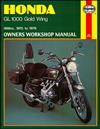
Softcover - 179 pages - Honda GL1000 Gold Wing 1975 - 1979 Haynes Owners Service Repair Manual Covers the following Models: Honda Gold Wing GL1000 Standard (USA) May 1975 to Sep. 1979 Honda Gold Wing GL1000 LTD (USA) 1976 Honda Gold Wing GL1000 K1 and K2 (U.K.) March 1975 to April 1979 Honda Gold Wing GL1000 KZ (U.K.) April to September 1979Contents: Maintenance Engine Clutch And Transmission Fuel System And Lubrication Ignition System Frame And Forks Wheels Brakes And Tyres Electrical System Wiring Diagrams
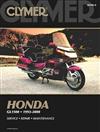
Softcover - 792 pages - Honda GL1500 Gold Wing 1993 - 2000 Clymer Owners Service Repair Manual Covers the following Models: GL1500SE Gold Wing Special Edition (1993-2000) GL1500A Gold Wing Aspencade (1993-2000) GL1500I Gold Wing Interstate (1993-2000)Contents: QUICK REFERENCE DATA GENERAL INFORMATIONManual organization / Notes cautions and warnings / Safety first / Service hints / Serial numbers / Parts replacement / Torque specifications / Fasteners / Lubricants / RTV Gasket sealant / Threadlock / Gasket remover / Expendable supplies / Basic hand tools / Test equipment / Precision measuring tools / Cleaning solvent / Other special tools / Mechanic #39;s tips / Ball bearing replacement / Oil seals / Riding safely / Specifications TROUBLESHOOTINGOperating requirements / Emergency troubleshooting / Engine starting procedures / Engine starting troubleshooting / Engine performance / Engine noises / Hydraulic valve adjuster system / Engine lubrication / Fuel
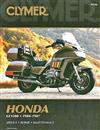
Softcover - 420 pages - Honda GL1200 Gold Wing 1984 - 1987 Clymer Owners Service Repair Manual Covers the following Models: GL1200 Standard (1984) GL1200A Aspencade (1984-1987) GL1200I Interstate (1984-1987) GL1200L Limited Edition (1985) GL1200SE-I Aspencade SE-i (1986)Contents: QUICK REFERENCE DATA GENERAL INFORMATIONManual organization / Service hints / Safety first / Torque specifications / Special tips / Expendable supplies / Parts replacement / Serial numbers / Tune-up and troubleshooting tools /Specifications TROUBLESHOOTINGOperating requirements / Emergency troubleshooting / Engine starting / Engine performance / Engine noises / Excessive vibration / Front suspension and steering / Brake problems /Electrical troubleshooting LUBRICATION MAINTENANCE AND TUNE-UPRoutine checks / Pre-checks / Service intervals / Periodic lubrication / Engine

Softcover. 856 pages - - Honda GL1500 Gold Wing 1988 - 1992 Clymer Owners Service Repair Manual Covers the following Models: Honda GL1500 Standard 1988 - 1990 Honda GL1500SE SE 1990 - 1992 Honda GL1500A Aspencade 1991 - 1992 Honda GL1500I Interstate 1991 - 1992Contents: Quick Reference Data General InformationManual Organization / Notes Cautions And Warnings / Safety First / Service Hints / Serial Numbers / Parts Replacement / Torque Specifications / Fasteners / Lubricants / Rtv Gasket Sealant / Threadlock / Gasket Remover / Expendable Supplies / Basic Hand Tools / Test Equipment / Precision Measuring Tools / Cleaning Solvent / Other Special Tools / Mechanic #39;s Tips / Ball Bearing Replacement / Oil Seals / Riding Safely / Specifications TroubleshootingOperating Requirements / Emergency Troubleshooting / Engine Starting Procedures / Engine Starting Troubleshooting / Engine Performance / Engine Noises / Hydraulic Valve Adjuster System / Engine Lubrication / Fuel System / Clutch / Transmission / Final Drive / Excessive Vibration / Front Su
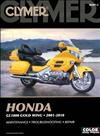
Softcover - 676 pages - Honda Gold Wing GL1800 2001 - 2010 Service Repair Manual Covers model years indicated and also includes a 2006 - 2010 supplement and all required wiring diagrams in the accompanying CD-ROM.Contents: Quick Reference Data General InformationManual Organization / Warnings Cautions And Notes / Safety / Serial Numbers / Fasteners / Shop Supplies / Basic Tools / Precision Measuring Tools / Electrical System Fundamentals / Basic Service Methods / Storage Specifications TroubleshootingOperating Requirements / Starting The Engine / Engine Will Not Start / Engine Performance / Fuel System / Engine / Engine Lubrication / Cylinder Leakdown Test / Clutch / Gearshift Linkage / Transmission / Electrical Testing / Final Drive / Front Suspension And Steering / Brake System / Cruise Control / Specifications Lubrication Maintenance And Tune-UpFuel / Tune-Up / Cylinder Identification And Firing Order / Air Filter / Engine Compression Test / Spark Plugs / Ignition Timing / Valve Clearance / Engine Idle Speed Inspection / Fuel Hose Inspection / Throttle Cable Lubrication / Throttle Cable Operation And Adjustment / Reverse Operation / Clutch / Engine
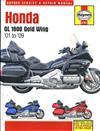
Softcover - 288 pages - Honda GL1800 Gold Wing 1800 2001 - 2009 Haynes Owners Service Repair Manual covers: Honda GL1800 Gold Wing 1800Contents: Living With Your Honda GL1800 Goldwing- Introduction- Safety First!- Identification Numbers- Buying Spare Parts- Pre-Ride Checks- Coolant Level- Engine Oil Level- Legal And Safety Checks- Brake Fluid Levels- Tyres- Suspension Steering And Drive Chain- Model Development Bike Specs Maintenance- Routine Maintenance And Servicing- Specifications- Lubricants And Fluids- Maintenance Schedule Procedures- Component Locations Repairs And Overhaul- Engine Transmission And Associated Systems- Engine Clutch And Transmission- Fuel And Exhaust Systems- Ignition System- Cooling System- Chassis Components- Frame And Suspension- Brakes Wheels And Final Drive- Fairing And Bodywork- Electrical System- Wiring Diagrams
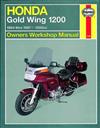
Softcover - 208 pages - Honda Gold Wing 1200 (USA) 1984 - 1987 Haynes Owners Service Repair Manual Covers GL1200 1182cc 1984 - 1987Note: Does not cover fuel injection modelsContents: Maintenance Engine Clutch And Transmission Cooling System Fuel And Exhaust Systems Ignition System Steering Suspension And Final Drive Wheels Brakes And Tyres Fairing Bodywork And Frame Electrical System Wiring Diagrams Conversion Factors
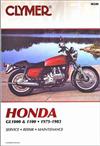
Softcover - 288 pages - Honda Gold Wing GL1000 GL1100 1975 - 1983 Clymer Owners Service Repair Manual Covers the following Models: Honda Gold Wing GL1000 1975-1979 Honda Gold Wing GL1100 Standard 1980-1983 Honda Gold Wing GL1100 Interstate 1980-1983Contents: Quick Reference Data General Information Troubleshooting Lubrication Maintenance and Tune-up Engine Clutch and External Gearshift Linkage Transmission and Internal Shift Mechanism Fuel and Emission Systems Exhaust System Electrical System Wheels Tyres and Drive Chain Front Suspension and Steering Rear Suspension Brakes Body and Frame Wiring Diagrams
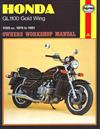
Softcover - 180 pages - Honda GL1100 Gold Wing 1979 - 1981 Haynes Owners Service Repair Manual Covers the following Models: Honda Gold Wing GL1100 Standard (USA) 1979 Honda Gold Wing GL1100 Interstate (USA) 1979 Honda Gold Wing GL1100-KA (UK) 1980 Honda Gold Wing GL1100-KB (UK) 1980 Honda Gold Wing GL1100-DB (UK) 1981 Honda Gold Wing GL1100-DB-DX (UK) 1981Contents: Maintenance Engine Clutch And Transmission Fuel System And Lubrication Ignition System Frame And Forks Wheels Brakes And Tyres Electrical System Wiring Diagrams
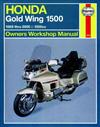
Softcover - 240 pages - Honda Gold Wing 1500 (USA) 1988 - 2000 Haynes Owners Service Repair Manual Covers Model GL1500 1502cc 1988 - 2000Contents: Maintenance Engine Clutch Transmission Fuel System Lubrication Ignition System Fairing Frame And Forks Wheels Brakes And Tyres Electrical System Wiring Diagrams
The people of auto designers of Japan includes a Honda silver Wing GL1000 manufactured in 1974 among their particular 240 Landmarks of Japanese Automotive Technology. Through 2012, Honda GL models has appeared eighteen circumstances inside pattern globe listing of Ten Best bicycles.
During the period of their background, it offers had numerous modifications to their design and production. In 1975 it had a 999 cc flat-four motor as well as in 2001 it have a 1,832 cc flat-six. By 2012, the design have a fairing with home heating and an adjustable windscreen, panniers and a trunk area, a seatback for pillion driver, satellite navigation and broadcast, a six-speaker speakers with MP3 and iPod connectivity, anti-lock stopping, cruise control, electrically assisted reverse gear, and an optional airbag, none which had been current with regards to is launched.
Silver Wings were manufactured in Marysville, Ohio from 1980 until 2010, when motorcycle manufacturing there was stopped. Production started again in Kumamoto Prefecture, Japan in 2011 utilizing tooling transported from old plant. The 2011 design seasons was not produced.
In 1972 Honda put together a design staff to explore principles for a fresh flagship motorcycle, something Honda R&D had deliberated over since the CB750 is launched. The venture chief had been Shoichiro Irimajiri, whom in the earlier ten years have designed Hondaâs five- and six-cylinder Grand Prix motorcycle rushing motors and then contributed to the development of Hondaâs vehicle business. Irimajiri-san ended up being hence an apt solution to produce an amalgamation of disparate technologiesâautomobile motors and multi-cylinder race bicycles.
an associated event had been the development of the CVCC clean-burn automobile system in the 1972 Tokyo program. It absolutely was Honda's earliest liquid-cooled engine going into manufacturing; Honda automobiles along with motorcycles have all become air-cooled around that time. Soichiro Honda was not quickly convinced that liquid-cooling had been better than air-cooled machines but more youthful designers eventually prevailed.
Honda F1 rushing RA273E 3-liter V12 engine designed by Shoichiro Irimajiri
M1 model
During their development within the belated 1960s, the CB750 was known as informally the "King of Motorcycles" so that it was installing that Honda's next huge thing would be understood because of the moniker "master of leaders" at creation. By the end of 1972, the venture staff have made some slack with motorcycle traditions in the form of an experimental prototype, recognized by the rule title M1. In the place of a transverse system design, the M1 motorcycle features a longitudinal system, rendering it ideal for a driveshaft and even though every previous Honda used a chain the final drive. Rather than a parallel twin or inline-four engine the M1 features a flat-six engine, as well as 1470cc, it has two times the displacement associated with the CB750. In place of creating they for über-performance the M1 motor ended up being developed to emit plenty of torque across a broad energy musical organization. Unlike almost every other Honda motorcycle of that time period, the M1 motor makes use of liquids air conditioning.
The M1 motor puts out 80 horse power at 6700 rpm, permitting a top speeds of 220 kilometres each hour. Unconstrained by practicalities, this brainstorm through the task team had been definately not a production model. On the contrary, the M1 was never meant to see the light of day. However, the M1 should be seen as the primordial silver Wing because many of the basic and identifying functions can be found in the lineage.
The flat-six provides the M1 bike an extremely lowest center of gravity, which improves security, although amount of this engine plus gearbox will not allow a comfy operating position, that has been so confined that the venture moved towards the notion of a far more small motor.
1976 GL1000 engine closeup
1938 Zündapp K800 on display at the Barber classic Motorsport Museum
1983 BFG 1300 motorcycle
Venture 371
The undefined touring bike was then code-named task 371, and Toshio Nozue took over from Irimajiri-san as task leader. The M1 engine displacement of 1470cc had been considered too large, and six cylinders had been regarded as being a lot of, for the target audience. The M1 build is in the course of time changed by a more compact one liter flat-four engine.
Powertrain pedigree
As soon as the silver Wing flat-four with shaft drive premiered in 1974 it blended technology from earlier motorcycle design, including current automotive tech. The original BMW Motorrad design, a wet-sump unit construction boxer-twin utilizing shaft final drive, dates back towards R32 model that began manufacturing in 1923. In 1934 Zündapp put the same powertrain design for their K800, stepping up to a four-cylinder boxer motor; during World War II the K800 ended up being the only four-cylinder bike employed by the German armed forces. The 500cc Wooler design of 1953 improved upon the Zündapp by adding overhead valves to its boxer four and back suspension to their tubular framework; although with capital an issue, followed by the loss of John Wooler, this committed shaft-drive bike never quite have from the ground.
In cars, the four-cylinder boxer powerplant goes dating back the beginning of the 20th century; as well as in early 1970s flat-four motors are becoming manufactured by Subaru, Lancia, Alfa Romeo, VW and Porsche as 4 and 6 cylinders, and utilized in plane because the Porsche PFM 3200, motor, and Citroën. The Citroën engine try remarkable because it was always run the BFG 1300 touring bicycle, which was furthermore well-liked by the French authorities in the 1980s.
The silver Wing is the initial production motorcycle from Japan that had a four-stroke system with liquid cooling however the Suzuki GT750 with a water-cooled, two-stroke triple, preceded the GL1000 by four ages. Two-stroke water-cooled machines through the Scott Motorcycle business go back at the least so far as the 1920s.
Marketplace
The principal marketplace for the Gold Wing ended up being the potential Long Distance driver, requiring a motorcycle appropriate towards the task. In North America that needed benefits when it comes to longterm: wind protection, smooth trip, comfortable seat, storage space the necessities, and energy in abundance. The additional marketplace was to maintain European countries in which riders, constrained by frontiers, highlighted performance over deluxe.
During the early 1970s, Americans with a tendency to cover vast distances have few brands to pick from: Harley-Davidson, Moto Guzzi and BMW. The Electra Glide was a comfortable, high-maintenance and high-vibration bike with fanatically loyal riders. But, Harley faced some severe competition from Moto Guzzi's then-new 850cc Eldorado.
The BMW was smoother, more dependable, but because costly because the Harley and best worthy of a weekend journey than crossing a continent. Large Japanese bicycles of the time, such as the Honda CB750 and the Kawasaki Z1 had been relatively cheap but difficult by vibration, because of the requirement for drive chain maintenance and also by fuel tanks too smaller with regards to their thirsty engines. The silver Wing ended up being aimed at market section that did not however exists: United states riders improbable buying a Harley or BMW but that would start their wallets for an affordable device supplying benefits, stamina, low-maintenance and a high-torque, smooth, peaceful engine. Honda would fundamentally become very effective in attracting a new variety of long distance driver.
A cylinder block try an integral construction comprising the cylinder of a reciprocating system and frequently some or their associated surrounding structures. The expression system block is frequently used synonymously with "cylinder block".
Into the basic regards to device elements, the different main areas of a motor, cylinder head, coolant passages, intake and exhaust passages, and crankcase) become conceptually distinct, that principles can all be instantiated as discrete parts which can be bolted collectively. These types of construction is very extensive during the early decades regarding the commercialization of internal combustion machines, and it is nonetheless occasionally utilized in certain applications where they remains beneficial. But is no much longer the conventional method of creating more petrol motors and diesel machines, because for any offered system configuration, there are many more efficient methods of designing for manufacture. These generally involve integrating numerous machine elements into one discrete part, and creating the making for numerous elements within one setup with one device coordinate program. This yields reduced product cost of manufacturing.
Nowadays many machines for automobiles, vehicles, buses, tractors, and so on are designed with relatively extremely incorporated build, so the statement "monobloc" and "en bloc" is seldom found in describing all of them; these types of construction is frequently implicit. Therefore "engine block", "cylinder block", or just "block" would be the terminology likely to be heard when you look at the storage or from the road.
The task 371 team's final powertrain design is a 1 litre liquid-cooled, horizontally-opposed four-cylinder, SOHC motor, with a gear-driven generator at the back end of crankshaft. Utilizing gears to-drive the generator caused they to spin backwards and therefore to counteract the engine torque response. Cylinder blocks and crankcase were key, aided by the transmission situated underneath the crankcase to keep the machine building motor as compact as you possibly can. Final drive was by shaft.
Manufacturing Gold Wings proceeded sale when you look at the U.S. and in European countries in 1975, but pre-production GL1000 models had been very first unveiled to dealers in September 1974 at United states Honda's yearly dealer meeting in nevada, after which demonstrated to the public these period on IFMA Internationale Fahrrad- und Motorrad-Ausstellung in Cologne.
Tiny fairings was mounted on two regarding the manufacturing prototypes the U.S. dealer program in Las vegas, nevada. These fairings were created by Honda become marketed as Hondaline add-ons, had been allowed to be stated in the U.S. by the Vetter Fairing business, but this kind of build never ever moved into manufacturing as a result of the accidental destruction associated with molds. Consequently, the silver Wing was born in to the world nude, lacking saddlebags and achieving no place for baggage, without a windshield. This produced a 'golden' window of opportunity for accessory providers, and an industry shortly created promoting fairings and baggage add-ons, especially the Windjammer series created by Craig Vetter.
The initial GL1000 had an electric powered starter copied by a kick start lever saved inside a dummy fuel container, which housed the radiator growth tank, electric elements, along with the air conditioner filter providing four Keihin 32 mm CV carburetors. The real gasoline tank had been under the chair, so that the biggest market of mass only feasible. The cycle had a dry pounds of 584 lbs and a retail cost of US $2,900. 13,000 Gold Wings are marketed in the us in 1975.
There were no considerable alterations in the conventional silver Wing for 1976 even though price increasing somewhat to $2,960. To mark the United States Bicentennial seasons Honda launched the GL1000 LTD with distinctive insignia and color plan and many additional amenities. The LTD was a genuine minimal version with manufacturing limited to about 3,400 devices, in accordance with an upscale cost of $3,295.
Into the third design year Honda began refining the silver Wing, even though the changes for 1977 had been tiny, such as fatigue pipe temperature shields, modified seat and handlebar, plus an innovative new gas measure. Body weight risen up to 595 lbs and price rose to $2,938. The bike unit of Honda UK produced 52 Executive GL1000 K1 bikes by adding premiums add-ons to 1977 silver Wings and offering all of them for £2300.
1979 GL1000 with Windjammer fairing on Bonneville sodium Flats
The motor ended up being changed in 1978 for GL1000 K3 model, so as to make additional torque offered by reduced system speeds; the carburetors are lower in size by 1 mm, the exhaust system is redesigned, valve timing and ignition timing are altered. The kick-start apparatus had been taken from the engine, and a reserve illumination component when it comes to headlight and taillight had been taken out of the electrics. A small tool panel showed up in addition to a restyled dummy gasoline tank. Wire-spoke wheels were changed with Honda's newer ComStar rims, although present tires with inner tubes remained. Dry weight expanded to 601 weight plus the value went around $3,200.
1979 marked the termination of GL1000 developing using the K4 design. Dry fat increasing a little to 604 weight as well as the value jumped to $3,700 during the last Gold Wing to-be powered by a one-liter motor. There were best small modifications for this model 12 months, except for the ComStar tires; new ComStars had stronger metal spokes on aluminum rims instead of the original aluminum spoked rims that precipitated a 1979 recall. Through the last run for the GL1000 in 1979, Hondaline saddlebags and trunk had been readily available, but Honda nevertheless would not offering a fairing.
Honda offered above 97,000 products of this GL1000 in the us between 1975 and 1979.
BMW Motorrad uses a method called Integral abdominal muscles, when the front brake lever operates both the front side and rear brakes, whilst braking system pedal operates just the rear brake. When you look at the inverse, Honda's program that has both combined brakes and anti-lock brakes was dubbed blended abdominal muscles. Inside program, a corner brake pedal works both front and rear brake, plus the front braking system lever operates the leading calipers, which activates another master cylinder to interact the rear braking system. abdominal muscles modulators tend to be set up on the front and rear wheel.
Hondaâs very first street bike with a blended braking program is the 1983 GL1100. This method is produced from a 1970s RCB1000 world endurance competition bicycle. Honda made a number of modifications for the LBS program with differing quantities of difficulty and integration. The CBR1100XX and VFR800 featured exactly what Honda labeled as LBS II, a system in which both levers would activate both brakes through a system of secondary pistons and proportioning/delay valves. One front brake caliper ended up being linked to a second master cylinder, additionally the caliper ended up being permitted to rotate slightly to make use of force to the piston in that secondary master cylinder. Braking power is converted into stress that was provided for the trunk braking system cylinder. Just the two outer pistons in the front braking system calipers are straight activated because of the braking system lever; the guts piston received stress from the rear pedal through the proportioning and wait valve.
From 2009 the Honda CBR1000RR and CBR600RR recreation bicycles tend to be optionally built with an integrated Dual CBS and abdominal muscles system which utilizes an electronic controls device to distribute hydraulic force between front side and rear brake system. The combined anti-lock stopping system is known as C-ABS.
After five years of GL1000, the second-generation Gold Wing was released in 1979 as a 1980 model, together with GL1100 is proceeded through the 1983 design year. The GL1100 was manufactured in Japan until might 1980 when Honda began building 1981 brands during the Marysville bike Plant in Ohio. Silver Wings would-be built at a level of 150 products every single day for years 1981-1983. Machines remained being built in Japan, but Honda started to promote the equipment as being made in America.
The Gold Wing experienced competition from Japan in the form of the Suzuki GS1000 with an inline-four motor, and especially within the Kawasaki Z1300 that had an enormous DOHC 1300cc straight-six system with liquids cooling. Honda responded by enhancing the displacement regarding the Gold Wing, and followed-up by announcing the initial Japanese full-dress tourer. The brand new engine ended up being more than just a GL1000 with a 3 mm bigger bore, the modifications plainly emphasized torque over horsepower. The cylinder minds are altered to boost burning at low and center engine rates, transmission gear ratios were changed additionally the last drive ratio shortened to help make additional torque offered at highway rates. The bore size for all four carburetors was once again paid down by 1 mm, to 30 mm.
The wheelbase is lengthened over that of the GL1000, and environment suspension system had been included. The GL1100 have an adjustable chair, and also for the very first time used tubeless tires, mounted on black reverse ComStar wheels. The naked Gold Wing, which will come to be referred to as Standard design, considered 589 lbs dry and sold for all of us $3,800. In spite of the fact here are only lesser adjustment to separate the GL1100 '81 version from earlier season, the price moved around $4,100.
Most of the 1982 silver Wings have transmission ratios modified to lower motor rpm at cruising rates, new brakes with twin-piston calipers and wider tires on smaller rims. Dry pounds the GL1100 '82 was 595 weight and the price had been $4,250.
Transmission gear ratios had been modified yet again the 1983 silver Wings to lessen engine speeds on the road. However the big adjustment weren't to the system, they certainly were on running gear within a year ago for GL1100s. Cast aluminum eleven-spoke rims replaced the ComStars. The leading suspension system is endowed with TRAC anti-dive forks with an integrated hand support, plus the back suspension worked despite no atmosphere pressure. Honda's earliest combined braking program, dubbed Unified Braking at the time, debuted in 1983; it involved both front and rear brake system in unison as soon as the braking system pedal ended up being used. Dry pounds for the traditional GL1100 inched around 599 weight additionally the cost crept as much as $4,300.
GL1100 Interstate
Honda went beyond the technical makeover of naked Gold Wing in March 1980 by releasing 1st Japanese turn-key tourer, the Interstate model with a factory-installed full fairing, saddlebags and a removable trunk, plus more information on optional extras including a stereo system. This cycle had been called the De Luxe model in some markets. The fairing ended up being built to protect the rider and a passenger through the wind. Also, the saddlebags and trunk had been designed to carry the baggage of two different people. This made the Interstate significantly thicker than the standard model, with a dry weight of 672 weight, and much more high priced at United States $4,900. The almost identical Interstate design for '81 is $5,100.
The GL1100I '82 model provided most options, including a brand new stereo, a 40-channel CB transceiver, and an on-board compressor to regulate the suspension system air pressure. Dry fat is 679 lbs and the cost had been $5,450.
The GL1100I '83 gotten the motor and running equipment news associated with the standard model; dry pounds increased to 686 pounds and value to $5,550.
In 1983 Honda had been facing difficult available on the market from a brand new full-dress tourer, the Yamaha Venture XVZ 1200 with its DOHC four valve per cylinder V4 engine. Honda struck back once again within Milan bike program belated that year by announcing a fresh 1984 Gold Wing that pressed their four-cylinder engine design to their limitations. The bored and stroked boxer produced most energy and torque; a new last drive ratio gave the GL1200 taller gearing in order to lower sounds and vibration. The four Keihin 32 mm CV carburetors are larger than those regarding GL1100 motor, alternatively, they certainly were similar size since the '75-'76 GL1000 carbs. Incorporating hydraulic actuation the clutch, as well as hydraulic tappets the valves, made this new engine practically maintenance-free. To make the silver Wing more nimble, front and back wheel diameters developed again. The GL1200 had been built on a brand new, more powerful framework and despite all progress, the stated dried out weight of nude bike stayed unchanged at 599 lbs, and it was costing $4,800 for 1984 model seasons.
1984 had been the best season for GL1200 traditional because sales had diminished in support of the Interstate and Aspencade brands. This led to the decline of aftermarket manufacturers like the Vetter Fairing Company.
The GL1200's competition had been getting more many. Final associated with huge Japanese brands to do so, Suzuki finally entered industry in 1985 with regards to full-dress tourer, the GV1400 Cavalcade with a DOHC, four valves per cylinder, V4 engine. In 1986 Yamaha increased the endeavor's V4 motor to 1300cc, and Kawasaki introduced the ZG 1200 Voyager XII with a four-valve, DOHC, Inline-four system.
With three variations of silver Wing boxer motor spanning several many years, by 1987 more improvement the flat-four motor ended up being thought to be becoming constrained because of the law of decreasing comes back. Piston displacement had been increasing twice to build even more torque, but and also this made each energy stroke additional intensive. Through the exact same time frame, equipment ratios have been lifted to reduce system RPM which in turn made pulses through drivetrain appear harsher towards driver because firing intervals were farther apart. Well-known method to provide energy even more efficiently would be to step up from four cylinders to six.
You might try the Gold Wing Riders Association. That or ABATE, those are all I can think of. I have searched for GW rentals in my area,,,not much luck either. Eric Sent from my iPhone using Tapatalk
The Honda cars use OBD2 and the wing doesn't use this. You can cancel the codes with the DLC reset tool that basically shorts two of the pins together on the DLC connector.
Wings tend to have air suspension which does allow some adjustment in height. I have a 2015 AC and a friend of mine who is the same height as you and I was able to lower it enough that he could just about flat foot it. I am on the other hand 5'8" and tend to run it half way up and I am comfortable there. Other options are getting the seat trimmed to remove extra foam and narrow the seat a bit ...
1997 Honda Gold Wing Aspencade, control that operates air vent cable, white square nut/ bolt that holds cable and pops through faring, that part I need.
I have been riding 2006 and 2017 gold wings and I'm only 5'5" . I do wear Red Wing boots but that is because I use to climb telephone poles and they fit the bill for that.
For Sale 2014 Gold Wing Audio Comfort $12,000.00 Rusty360 Mar 24, 2025 Member Classifieds Cypress, Texas 7 847
Anybody know what can or does cause the TPMS light to come on intermittently? I know the owners manual says to have the system checked when it comes on, but by the time I get to the shop it's gone out again so I don't know if there is anything that can be checked at that point. Thanks!
Honda Gold Wing 2023 Navigation Update From the Honda Update webpage..... Map Update Also Includes Features From the 2020 Update: Android Auto Compatibility* Audio Equalizer Adjustments New Navi Automatic Volume Adjustment New Four-Color Map Selection New ETA Function Speed Limit Signs Shown...
Being that I also have the wing boards on my trike, I'm considering removing the heel/toe shifter and the Kuryakun floor boards and just use the wing boards to rest my feet on. That should give me enough clearance to place my foot under the shifter to up-shift and should also further increase my leg/foot position. We'll see,,,.
A forum community dedicated to Honda Goldwing owners and enthusiasts. Come join the discussion reviews, performance, touring, modifications, troubleshooting, maintenance, and more!